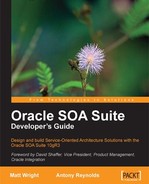Book Description
Design and build Service-Oriented Architecture Solutions with the Oracle SOA Suite 10gR3
A hands-on guide to using and applying the Oracle SOA Suite in the delivery of real-world SOA applications.
Detailed coverage of the Oracle Service Bus, BPEL Process Manager, Web Service Manager, Rules, Human Workflow, and Business Activity Monitoring.
Master the best way to combine / use each of these different components in the implementation of a SOA solution.
llustrates key techniques and best practices using a working example of an online auction site (oBay).
In Detail
We are moving towards a standards-based Service-Oriented Architecture (SOA), where IT infrastructure is continuously adapted to keep up with the pace of business change. Oracle is at the forefront of this vision, with the Oracle SOA Suite providing the most comprehensive, proven, and integrated tool kit for building SOA based applications.
Developers and Architects using the Oracle SOA Suite, whether working on integration projects, building composite applications, or specializing in implementations of Oracle Applications, need a hands-on guide on how best to harness and apply this technology.
This book will guide you on using and applying the Oracle SOA Suite to solve real-world problems, enabling you to quickly learn and master the technology and its applications.
The initial section of the book is aimed at providing you with a detailed hands-on tutorial to each of the core components that make up the Oracle SOA Suite; namely the Oracle Service Bus, BPEL Process Manager, Human Workflow, Business Rules, and Business Activity Monitoring. Once you are familiar with the various pieces of the SOA Suite and what they do, the next question will typically be: "What is the best way to combine / use all of these different components to implement a real-world SOA solution?"
Answering this question is the goal of the next section. Using a working example of an online auction site (oBay), it leads you through key SOA design considerations in implementing a robust solution that is designed for change. Though the examples in the book are based on Oracle SOA Suite 10.1.3.4 the book will still be extremely useful for anyone using 11g.
The final section addresses non-functional considerations and covers the packaging, deployment, and testing of SOA applications; it then details how to use Web Service Manager to secure and administer SOA applications.
Table of Contents
- Oracle SOA Suite Developer's Guide
- Credits
- Foreword
- About the Authors
- About the Reviewers
- Preface
- 1. Introduction to Oracle SOA Suite
- 2. Writing Your First Service
- 3. Service Enabling Existing Systems
- Types of systems
- Java Connector Architecture
- Creating services from files
- A payroll use case
- Reading a payroll file
- Throttling the file and FTP adapter
- Writing a payroll file
- Moving, copying, and deleting files
- Adapter headers
- Testing the file adapters
- Creating services from databases
- Summary
- 4. Loosely Coupling Services
- 5. Using BPEL to Build Composite Services and Business Processes
- 6. Adding in Human Workflow
- 7. Using Business Rules to Define Decision Points
- 8. Building Real-time Dashboards
- 9. oBay Introduction
- 10. Designing the Service Contract
- Using XML Schema to define business objects
- Using WSDL to define business services
- Using XML Schema and the WSDL within BPEL PM
- Strategies for managing change
- Summary
- 11. Building Business Services
- 12. Building Validation into Services
- Using XML Schema validation
- Using Schematron for validation
- Putting validation in the underlying service
- Layered validation considerations
- Summary
- 13. Error Handling
- Business faults
- Handling business faults in BPEL
- Using the fault management framework
- Handling faults within the service bus
- Summary
- 14. Message Interaction Patterns
- 15. Workflow Patterns
- Managing multiple participants in a workflow
- Using the workflow API
- Summary
- 16. Using Business Rules to Implement Services
- 17. The Importance of Bindings
- 18. Packaging and Deployment
- The need for packaging
- SOA Suite packaging
- Oracle Service Bus
- Oracle BPEL Process Manager
- Oracle Web Services Manager (OWSM)
- Oracle rules
- Business activity monitoring
- Deployment architectures
- Summary
- 19. Testing Composite Applications
- 20. Defining Security and Management Policies
- Security and management challenges in the SOA environment
- Securing services
- Creating gateways and agents
- Defining policies
- Monitoring services
- Summary
